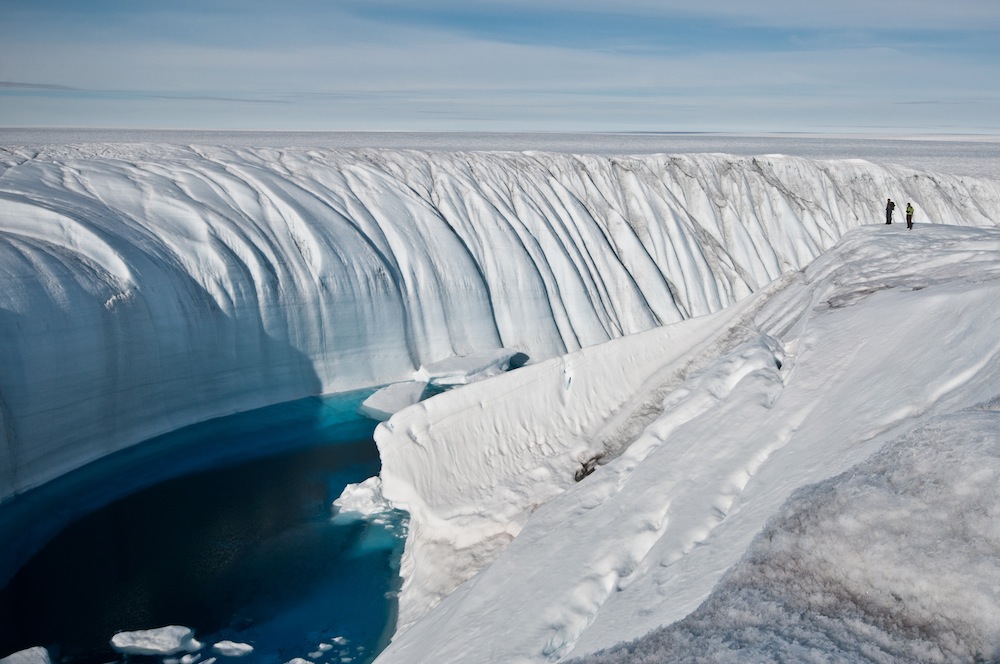Polar Ice Loss Accelerating, Study Finds

Ice loss in Antarctica and Greenland has contributed nearly half an inch to the rise in sea levels in the past 20 years, according to an assessment of polar ice sheet melting that researchers are calling the most reliable yet.
What's more, ice loss is rapidly speeding up in the north, while the rate in Antarctica has been fairly constant, the researchers report Friday (Nov. 29) in the journal Science.
Ice loss has been notoriously difficult to measure, and different studies have produced wildly different results, but the new study combines their methods to determine that the ice lost from Antarctica and Greenland accounts for .44 inches (11.1 millimeters), or a fifth, of the 2.2 inches that the seas have risen on average since 1992, said Ian Joughin, a glaciologist at the University of Washington in Seattle who collaborated on the study.
The rest of the sea level rise has been caused by melting of other ice around the world and by thermal expansion of ocean waters, which take up more space as they get warmer. Sea-level rise is not distributed evenly over the globe; some areas, such as off the U.S. Northeast, are disproportionately affected.
"Greenland is losing mass at about five times the rate today as it was in the early 1990s," study researcher Erik Ivins, an earth scientist at NASA's Jet Propulsion Laboratory, said in a press conference about the results. "In some contrast, Antarctica appears to be more or less constant, although for the last decade we appear to see about a 50 percent increase in ice-loss rate." [Images of Melt: Earth's Vanishing Ice]
Measuring melt
Climate and Earth scientists have long been concerned about the melting of the polar ice sheets, which has the potential to contribute to massive sea-level rise as the planet warms. Current projections range from somewhere between 8 inches (20 centimeters) and 6.6 feet (2 meters) of total sea-level rise over the course of this century.
Get the world’s most fascinating discoveries delivered straight to your inbox.
But even figuring out how much ice is already gone is a difficult job. For one thing, ice loss and accumulation vary a lot from year to year, Joughin said. That means researchers have to look at multiple-year chunks of time.
Ivins says different studies of the ice sheets have had different strengths and weaknesses. "People were looking at different time spans, they were looking at data sets that had great fidelity in one region and not great fidelity in another region, or they were able to capture the physics of ice-sheet change for one aspect and very poorly for another," he said.
The result was a wide spread of ice-change estimates, ranging from a yearly loss of 676 metric gigatons of ice from Greenland and Antarctica combined, all the way to an actual accumulation of 69 metric gigatons each year. (A metric gigaton is a billion metric tons.)
Led by University of Leeds researcher Andrew Shepherd in the United Kingdom, the new effort is the first to combine these methods and compare them in an "apples to apples" way, Joughin said. Researchers on the project said their results were the most reliable yet in estimating sea ice losses.
Ice loss accelerating
The combination of previous observations revealed that no matter how you slice it, the poles are losing ice.
Between 1992 and 2011, Antarctica lost 1,320 metric gigatons (plus or minus 980) of ice, while Greenland lost 2,940 metric gigatons (plus or minus 940). Western Antarctica is losing significant amounts of ice, while eastern Antarctica is compensating somewhat by gaining some ice. That's consistent with patterns climate scientists have found that show climate change driving increased snowfall in eastern Antarctica, Shepherd told reporters.
Accelerating ice loss has also boosted ice sheets' contribution to sea-level rise over the last two decades, said Michiel van den Broeke, a study researcher from Utrecht University in the Netherlands. When averaged out over the past 20 years, ice-sheet melting has contributed about 20 percent of the overall sea-level rise, but when looking at the past few years, van den Broeke said, it has accounted for 30 percent to 40 percent of continuing sea-level rise. A study just released in the journal Environmental Research Letters finds that sea level is currently rising 0.12 inches (3.2 millimeters) annually, 60 percent faster than the estimate calculated by the Intergovernmental Panel on Climate Change in 2007.
What researchers don't yet know is what the past ice-loss numbers say about the future. Greenland, especially, is seeing a major acceleration in ice loss, Joughin said. (This year, the summer Greenland ice melt broke a 30-year record, losing more ice than it ever has since record keeping began.) But you can't extrapolate the future from those trends, he said.
"It really remains unclear whether such losses will decline, whether it will level off or whether they will accelerate further," Joughin said. "To understand what is going to happen in the next century, we need models – and right now those models are very much limited by lack of data."
Follow Stephanie Pappas on Twitter @sipappas or LiveScience @livescience. We're also on Facebook & Google+.

Stephanie Pappas is a contributing writer for Live Science, covering topics ranging from geoscience to archaeology to the human brain and behavior. She was previously a senior writer for Live Science but is now a freelancer based in Denver, Colorado, and regularly contributes to Scientific American and The Monitor, the monthly magazine of the American Psychological Association. Stephanie received a bachelor's degree in psychology from the University of South Carolina and a graduate certificate in science communication from the University of California, Santa Cruz.





